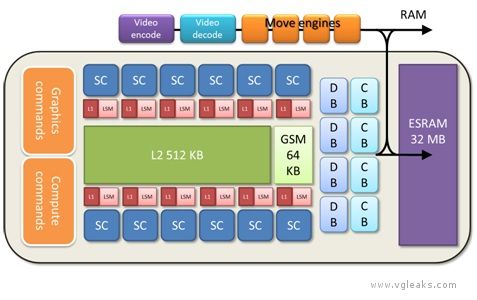Detailed information about Durango GPU.

|
Stat |
Value |
|
Clock rate |
800 MHz |
|
Compute |
|
|
Shader cores |
12 |
|
Instruction issue rate |
12 SCs * 4 SIMDs * 16 threads/clock = 768 ops/clock |
|
FLOPs |
768 ops/clock * (1 mul + 1 add) * 800 MHz = 1.2 TFLOPS |
|
Interpolation |
( 768 ops/clock / 2 ops ) * 800 MHz = 307.2 Gfloat/sec |
|
Geometry |
|
|
Triangle rate |
2 tri/clock * 800 MHz = 1.6 Gtri/sec |
|
Vertex rate |
2 vert/clock * 800 MHz = 1.6 Gvert/sec |
|
Vertex/buffer fetch rate (4 bytes) |
4 elements/clock * 12 SCs * 800 MHz = 38.4 Gelement/sec |
|
Vertex/Buffer data rate from cache |
38.4 Gelements/sec * 4 bytes = 153.6 GB/sec |
|
Memory |
|
|
Peak throughput from main RAM |
68 GB/sec |
|
Peak throughput from ESRAM |
128 bytes/clock * 800 MHz = 102.4 GB/sec |
|
ESRAM size |
32 MB |
|
GSM size |
64 KB |
|
LSM size |
12 SCs * 64 KB = 768 KB |
|
L2 cache size |
4 x 128 KB = 512 KB (shared) |
|
Texture |
|
|
Bilinear fetch rate (4 bytes) |
4 fetches/clock * 12 SCs * 800 MHz = 38.4 Gtexels/sec |
|
Bilinear data rate from cache |
38.4 Gtexels/sec * 4 bytes = 153.6 GB/sec |
|
L1 cache size |
16 KB/SC * 12 SCs = 192 KB (nonshared) |
|
Output |
|
|
Color/depth blocks |
4 |
|
Pixel clear rate |
1 8×8 tile/clock * 4 DBs * 800 MHz = 204.8 Gpixel/sec |
|
Pixel hierarchical Z cull rate |
1 8×8 tile/clock * 4 DBs * 800 MHz = 204.8 Gpixel/sec |
|
Sample Z cull rate |
16 /clock * 4 DBs * 800 MHz = 51.2 Gsample/sec |
|
Pixel emit rate |
4 /clock * 4 DBs * 800 MHz = 12.8 Gpixel/sec |
|
Pixel resolve rate |
4 /clock * 4 DBs * 800 MHz = 12.8 Gpixel/sec |
See more: http://www.vgleaks.com/durango-gpu/
Nothing new of course.

















